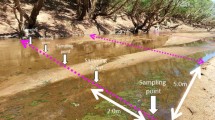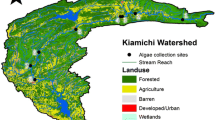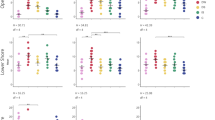Abstract
Wetlands in south-eastern Australia and other arid regions of the world are experiencing increases in salinity due to dryland salinization and climate change. We investigated changes in wetland ecological function, measured as phytoplankton and benthic algal Chl a, over a large salinity gradient (0.047–226 mS cm−1) and in relation to several local water chemistry variables that may be important predictors of algal biomass. We investigated the relative importance of landscape variables that may affect input pollution and hydrology of wetlands at four spatial scales (100, 500, 1,000 and 5000 m). We explored the strength and form of the relationships between algal biomass and local and landscape predictors with emphasis on the effects of local and landscape salinity. We found local variables were more important than landscape variables in influencing algal biomass. We also found salinity of wetlands was not a good predictor of phytoplankton biomass but it did predict benthic algal biomass.


Similar content being viewed by others
References
Allan JD (2004) Landscapes and riverscapes: the influence of land use on stream ecosystems. Annu Rev Ecol Evol Syst 35:257–284
Allan J, Johnson L (1997) Catchment-scale analysis of aquatic ecosystems. Freshw Biol 37:107–111
APHA (1989) Standard methods for the examination of water and wastewater, American Public Health Association, American Water Works Association, Water Pollution Control Federation, Washington, DC, 1550
Austin MP (2002) Spatial prediction of species distribution: an interface between ecological theory and statistical modelling. Ecol Modell 157:101–118
Barry S, Elith J (2006) Error and uncertainty in habitat models. J Appl Ecol 43:413–423
Bauld J (1981) Occurrence of benthic microbial mats in saline lakes. Hydrobiologia 81(2):87–111
Bayly IAE, Williams WD (1966) Chemical and biological studies on some saline lakes of south-east Australia. Aust J Marine Freshw Res 17:177–228
Beal MJ, Falciani F, Ghahramani Z, Rangel C, Wild DL (2005) A Bayesian approach to reconstructing genetic regulatory networks with hidden factors. Bioinformatics 21:349–356
Bennetts DA, Webb JA, Stone DJM, Hill DM (2006) Understanding the salinisation process for groundwater in an area of south-eastern Australia, using hydrochemical and isotopic evidence. J Hydrol 323:178–192
Biggs BJF (1995) The contribution of flood disturbance, catchment geology and land use to the habitat template of periphyton in stream ecosystems. Freshw Biol 33:419–438
Bini LM, Diniz-Filho JAF, Hawkins BA (2004) Macroecological explanations for differences in species richness gradients: a canonical analysis of South American birds. J Biogeogr 31:1819–1827
Blinn DW (1993) Diatom community structure along physicochemical gradients in saline lakes. Ecology 74:1246–1263
BOM (2005) Climate Data Online. Bureau of Meteorology, Commonwealth of Australia, Canberra
Borowitzka LJ (1981) The microflora. Adaptations to life in extremely saline lakes. Hydrobiologia 81:33–46
Bowler JM (1976) Aridity in Australia—age, origins and expression in Aeolian landforms and sediments. Earth Sci Rev 12:279–310
Brouwer J, Fitzpatrick RW (2002) Interpretation of morphological features in a salt-affected duplex soil toposequence with an altered soil water regime in western Victoria. Aust J Soil Res 40:903–926
Cai WJ, Cowan T (2008a) Dynamics of late autumn rainfall reduction over southeastern Australia. Geophys Res Lett 35:L09708
Cai WJ, Cowan T (2008b) Evidence of impacts from rising temperature on inflows to the Murray-Darling Basin. Geophys Res Lett 35:L07701
Camilleri S, Thomson J, Mac Nally R (2009). The interaction between landuse and physiogamy: understanding avifaunal patterns of the Murray Darling Basin, Australia. J Biogeogr (in press)
Cardinale B, Srivastava D, Duffy J, Wright J, Downing A, Sankaran M, Jouseau C (2006) Effects of biodiversity on the functioning of trophic groups and ecosystems. Nature (in press)
Cheruvelil KS, Soranno PA (2008) Relationships between lake macrophyte cover and lake and landscape features. Aquat Bot 88:219–227
Chown SL, Gaston KJ, Robinson D (2004) Macrophysiology: large-scale patterns in physiological traits and their ecological implications. Funct Ecol 18:159–167
Clarke A, Mac Nally R, Bond N, Lake PS (2008) Macroinvertebrate diversity in headwater streams: a review. Freshw Biol 53:1707–1721
Cook PG, Kennett-Smith AK, Walker GR, Budd GR, Williams RM, Anderson R (1997) Impact of dryland agriculture on land and river salinisation in the Western Lands, NSW. Aust J Soil Water Conserv 10:29–36
Coram, JE, (1996) Groundwater–surface water interactions around shallow lakes of the Western District Plains, Victoria. Masters Science, University of Melbourne, Melbourne
Cornillon P-A, Saint-Andre L, Bouvet J-M, Vigneron P, Saya A, Gouma R (2003) Using B-splines for growth curve classification: applications to selection of eucalypt clones. For Ecol Manage 176:75–85
Cottingham KL, Carpenter SR (1998) Population, community, and ecosystem variates as ecological indicators: phytoplankton responses to whole-lake enrichment. Ecol Appl 8:508–530
Cramer VA, Hobbs RJ (2002) Ecological consequences of altered hydrological regimes in fragmented ecosystems in southern Australia: impacts and possible management responses. Austral Ecol 27:546–564
D’Elia CF, Steudler PA, Corwin N (1977) Determination of total nitrogen in aqueous samples using persulfate digestion. Limnol Oceanogr 22:760–764
Dahlhaus PG, Heislers D, Dyson P (2002) Groundwater flow systems of the Glenelg Hopkins Catchment Management Authority region. Report No. GHCMA 02/02. Glenelg Hopkins Catchment Management Authority, Hamilton p 75 (unpublished data)
Darcy-Hall TL (2006) Relative strengths of benthic algal nutrient and grazer limitation along a lake productivity gradient. Oecologia 148:660–671
Davis JA, Mcguire M, Halse SA, Hamilton D, Horwitz P, Mccomb AJ, Froend RH, Lyons M, Sim L (2003) What happens when you add salt: predicting impacts of secondary salinisation on shallow aquatic ecosystems by using an alternative-states model. Aust J Bot 51:715–724
Department of Sustainability and Environment, 2004 Corporate Geospatial Data Library Department of Sustainability and Environment
Diniz-Filho JAF, Bini LM, Hawkins BA (2003) Spatial autocorrelation and red herrings in geographical ecology. Glob Ecol Biogeogr 12:53–64
Dormann CF (2007) Effects of incorporating spatial autocorrelation into the analysis of species distribution data. Glob Ecol Biogeogr 16:129–138
Findlay CS, Houlahan J (1997) Anthropogenic correlates of species richness in southeastern Ontario Wetlands. Conserv Biol 11:1000–1009
Fonseca CR, Ganade G (2001) Species functional redundancy, random extinctions and the stability of ecosystems. J Ecol 89:118–125
Forsythe GE, Malcolm MA, Moler CB (1977) Computer methods for mathematical computations, Prentice Hall, Englewood Cliffs, NJ (Professional Technical Reference)
Fraterrigo J, Downing J (2008) The influence of land use on lake nutrients varies with watershed transport capacity. Ecosystems 11:1021–1034
Frost P, Larson J, Johnston C, Young K, Maurice P, Lamberti G, Bridgham S (2006) Landscape predictors of stream dissolved organic matter concentration and physicochemistry in a Lake Superior river watershed. Aquat Sci Res Across Boundaries 68:40–51
Gamfeldt L, Hillebrand H, Jonsson PR (2008) Multiple functions increase the importance of biodiversity for overall ecosystem functioning. Ecology 89:1223–1231
Gergel SE, Turner MG, Kratz TK (1999) Dissolved organic carbon as an indicator of the scale of watershed influence on lakes and rivers. Ecol Appl 9:1377–1390
Green PJ (1995) Reversible jump Markov chain Monte Carlo computation and Bayesian model determination. Biometrika 82:711–732
Hammer UT (1986) Saline lake ecosystems of the world. Dr. W. Junk Publishers, Dordrecht 615
Hart EA, Lovvorn JR (2000) Vegetation dynamics and primary production in saline, lacustrine wetlands of a Rocky Mountain basin. Aquat Bot 66:21–39
Hart B, Bailey P, Edwards R, Hortle K, James K, Mcmahon A, Meredith C, Swadling K (1991) A review of the salt sensitivity of the Australian freshwater biota. Hydrobiologia 210:105–144
Herbst DB (2006) Salinity controls on trophic interactions among invertebrates and algae of solar evaporation ponds in the Mojave Desert and relation to shorebird foraging and selenium risk. Wetlands 26:475–485
Herbst DB, Blinn DW (1998) Experimental mesocosm studies of salinity effects on the benthic algal community of a saline lake. J Phycol 34:772–778
Hoeting JA, Madigan D, Raftery AE, Volinsky CT (1999) Bayesian model averaging: a tutorial. Stat Sci 14:382–401
Houlder D, Hutchinson M, Nix H, Mcmahon J (2000) ANUCLIM User Guide, Version 5.1, Centre for Resource and Environmental Studies. Australian National University, Canberra
James KR, Cant B, Ryan T (2003) Responses of freshwater biota to rising salinity levels and implications for saline water management: a review. Aust J Bot 51:703–713
Johnson L, Richards C, Host G, Arthur J (1997) Landscape influences on water chemistry in Midwestern stream ecosystems. Freshw Biol 37:193–208
Kass RE, Raftery AE (1995). Bayes factors. Journal of the American Statistical Association 90
Knoll LB, Vanni MJ, Renwick WH (2003) Phytoplankton primary production and photosynthetic parameters in reservoirs along a gradient of watershed land use. Limnol Oceanogr 48:608–617
Lawrie K, Williams MAJ (2004). Improving salinity hazard predictions by factoring in a range of human impacts in the context of climate change. In: Regolith Conference. Roach IC (ed), Cooperative Research Centre for Landscape Environments and Mineral Exploration pp 199–203
Legendre P (1993) Spatial autocorrelation—trouble or new paradigm? Ecology 74:1659–1673
Lorenzen CJ (1967) Determination of chlorophyll and pheopigments: spectrophotometric equations. Limnol Oceanogr 12:343–346
Lougheed VL, Mcintosh MD, Parker CA, Stevenson R (2008) Wetland degradation leads to homogenization of the biota at local and landscape scales. Freshw Biol 53:2402–2413
Mac Nally RC (1990) Modelling distributional patterns of woodland birds along a continental gradient. Ecology 71:360–374
Mac Nally R, Horrocks G, Lada H, Lake S, Thomson JR, Taylor AC (2009) Distribution of anuran amphibians in massively altered landscapes in south-eastern Australia: effects of climate change in an aridifying region. Glob Ecol Biogeogr 18:575–585
Macpherson DK, Peck AJ (1987) Models of the effect of clearing on salt and water export from a small catchment. J Hydrol 94:163–179
Marx SK, Kamber BS, Mcgowan HA (2005) Estimates of Australian dust flux into New Zealand: quantifying the eastern Australian dust plume pathway using trace element calibrated 210Pb as a monitor. Earth Planet Sci Lett 239:336–351
Mensing DM, Galatowitsch S, Tester J (1998) Anthropogenic effects on the biodiversity of riparian wetlands of a northern temperate landscape. J Environ Manage 53:349–377
Naeem S, Wright JP (2003) Disentangling biodiversity effects on ecosystem functioning: deriving solutions to a seemingly insurmountable problem. Ecol Lett 6:567–579
Nathan E (1999) Dryland salinity on the Dundas Tableland: a historical appraisal. Aust Geogr 30:295–310
Nielsen DL, Brock MA, Petrie R, Crossle K (2007) The impact of salinity pulses on the emergence of plant and zooplankton from wetland seed and egg banks. Freshw Biol 52:784–795
Nix H (1986) A biogeographic analysis of Australian Elapid Snakes. In: Longmore R (ed) Atlas of Elapid Snakes of Australia. Australian Flora and Fauna Series Number 7. Australian Government Publishing Service, Canberra, pp 4–15
Odum EP, Finn JT, Franz EH (1979) Perturbation theory and the subsidy-stress gradient. BioScience 29:349–352
Oduor SO, Schagerl M (2007) Phytoplankton primary productivity characteristics in response to photosynthetically active radiation in three Kenyan Rift Valley saline alkaline lakes. J Plankton Res 29:1041–1050
Pilkaityte R, Schoor A, Schubert H (2004) Response of phytoplankton communities to salinity changes—a mesocosm approach. Hydrobiologia 513:27–38
Potter AT, Palmer MW, Henley WJ (2006) Diatom genus diversity and assemblage structure in relation to salinity at the Salt Plains National Wildlife Refuge, Alfalfa County, Oklahoma. Am Midl Nat 156:65–74
Prasuhn V, Sieber U (2005) Changes in diffuse phosphorus and nitrogen inputs into surface waters in the Rhine watershed in Switzerland. Aquat Sci Res Across Boundaries 67:363–371
R Development Core Team (2005) R: a language and environment for statistical computing. R Foundation for Statistical Computing, Vienna, Austria
Radke L, Howard K (2007) Influence of groundwater on the evaporative evolution of saline lakes in the Wimmera of south-eastern Australia. Hydrobiologia 591:185–205
Radke LC, Howard KWF, Gell PA (2002) Chemical diversity in south-eastern Australian saline lakes I: geochemical causes. Marine Freshw Res 53:941–959
Rangel TFLVB, Diniz-Filho J, Alexandre F, Bini LM (2006) Towards an integrated computational tool for spatial analysis in macroecology and biogeography. Glob Ecol Biogeogr 15:321–327
Rengasamy P (2002) Transient salinity and subsoil constraints to dryland farming in Australian sodic soils: an overview. Aust J Exp Agric 42:351–361
Rengasamy P (2006) World salinization with emphasis on Australia. J Exp Bot 57:1017–1023
Reynolds CS (2003) Planktic community assembly in flowing water and the ecosystem health of rivers. Ecol Modell 160:191–203
Rothschild LJ, Mancinelli RL (2001) Life in extreme environments. Nature 409:1092–1101
Schofield KA, Pringle CM, Meyer JL, Rosi-Marshall EJ (2008) Functional redundancy of stream macroconsumers despite differences in catchment land use. Freshw Biol 53:2587–2599
Schomberg J, Host G, Johnson L, Richards C (2005) Evaluating the influence of landform, surficial geology, and land use on streams using hydrologic simulation modeling. Aquat Sci Res Across Boundaries 67:528–540
Sim LL, Davis JA, Chambers JM, Strehlow K (2006) What evidence exists for alternative ecological regimes in salinising wetlands? Freshw Biol 51:1229–1248
Smith M, Schreiber E, Kohout M, Ough K, Lennie R, Turnbull D, Jin C, Clancy T (2007) Wetlands as landscape units: spatial patterns in salinity and water chemistry. Wetl Ecol Manage 15:95–103
Smith MJ, Scroggie MP, Schreiber ESG, Mcnabb E, Cheers G, Macak P, Loyn R, Ough K (2009) Associations between salinity and use of non-riverine wetland habitats by diurnal birds. Emu 109:252–259
Smol JP, Cumming BF (2000) Tracking long-term changes in climate using algal indicators in lake sediments. J Phycol 36:986–1011
Spielgelhalter D, Thomas A, Best N (2003) WinBUGS version 1.4. Bayesian inference using Gibbs sampling. In: Biostatistics Unit, Institute for Public Health. Cambridge, United Kingdom
Srivastava DS, Jefferies RL (1996) A positive feedback: herbivory, plant growth, salinity, and the desertification of an Arctic salt-marsh. J Ecol 84:31–42
Stevenson RJ (1997) Scale-dependent determinants and consequences of benthic algal heterogeneity. J North Am Benthol Soc 16:248–262
Stiling P, Moon D (2005) Are trophodynamic models worth their salt? Top-down and bottom-up effects along a salinity gradient. Ecology 86:1730–1736
Stolte WJ, Mcfarlane DJ, George RJ (1997) Flow systems, tree plantations, and salinisation in a Western Australian catchment. Aust J Soil Res 35:1213–1229
Tank SE, Schindler DW, Arts MT (2003) FDirect and indirect effects of UV radiation on benthic communities: epilithic food quality and invertebrate growth in four montane lakes. Oikos 103:651–667
Thomson JR, Mac Nally R, Fleishman E, Horrocks G (2007) Predicting bird species distributions in reconstructed landscapes. Conserv Biol 21:752–766
Thomson JR, Moilanen AJ, Vesk PA, Bennett AF, Nally RM (2009) Where and when to revegetate: a quantitative method for scheduling landscape reconstruction. Ecol Appl 19:817–828
Tibby J, Tiller D (2007) Climate–water quality relationships in three Western Victorian (Australia) lakes 1984–2000. Hydrobiologia 591:219–234
Timms BV (1981) Primary production in three lakes of differing salinity in Victoria, Australia. Hydrobiologia 79:233–238
Van Buuren S, Groothuis-Oudshoorn K (2009) Mice: Multivariate Imputation by Chained Equations. R package version 1.21. http://www.stefvanbuuren.nl; http://www.multiple-imputation.com
Viallefont V, Raftery AE, Richardson S (2001) Variable selection and Bayesian model averaging in case–control studies. Stat Med 20:3215–3230
Vuilleumier S, Fontanillas P (2007) Landscape structure affects dispersal in the greater white-toothed shrew: inference between genetic and simulated ecological distances. Ecol Modell 201:369–376
Webb JA, Bond NR, Wealands SR, Nally RM, Quinn GP, Vesk PA, Grace MR (2007) Bayesian clustering with AutoClass explicitly recognises uncertainties in landscape classification. Ecography 30:526
Wiens JA (2002) Riverine landscapes: taking landscape ecology into the water. Freshw Biol 47:501–515
Williams WD (1966) Conductivity and concentration of total dissolved solids in Australian lakes. Aust J Marine Freshw Res 17:169
Williams WD (1987) Salinization of rivers and streams—an important environmental-hazard. Ambio 16:180–185
Williams WD (1999) Salinisation: a major threat to water resources in the arid and semi-arid regions of the world. Lakes Reservoirs: Res Manage 4:85–91
Williams WD (2001) Anthropogenic salinisation of inland waters. Hydrobiologia 466:329–337
Young RG, Huryn AD (1999) Effects of land use on stream metabolism and organic matter turnover. Ecol Appl 9:1359–1376
Acknowledgments
This research was supported by multi-regional National Action Plan funding (Project number 202167). BLC held a Monash “Ten off the Top” Postgraduate Scholarship for areas of research priority. The research was made possible by the support and cooperation of Greening Australia and private landowners: David and Jillie Deane, John Anderson, Toni Mahoney and the Mahoney family. Thanks to Sheila Hamilton-Brown, Eve West, Bronwyn Burger, Alister Cant, Margaret Cooper and Hamish McKindlay for field assistance. This is publication #189 from the Australian Centre for Biodiversity, Monash University.
Author information
Authors and Affiliations
Corresponding author
Rights and permissions
About this article
Cite this article
Cant, B., Nally, R.M., Thomson, J.R. et al. Relative effects of local and landscape factors on wetland algal biomass over a salinity gradient. Aquat. Sci. 72, 191–202 (2010). https://doi.org/10.1007/s00027-009-0119-x
Received:
Accepted:
Published:
Issue Date:
DOI: https://doi.org/10.1007/s00027-009-0119-x




